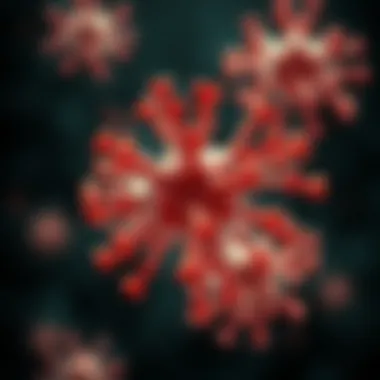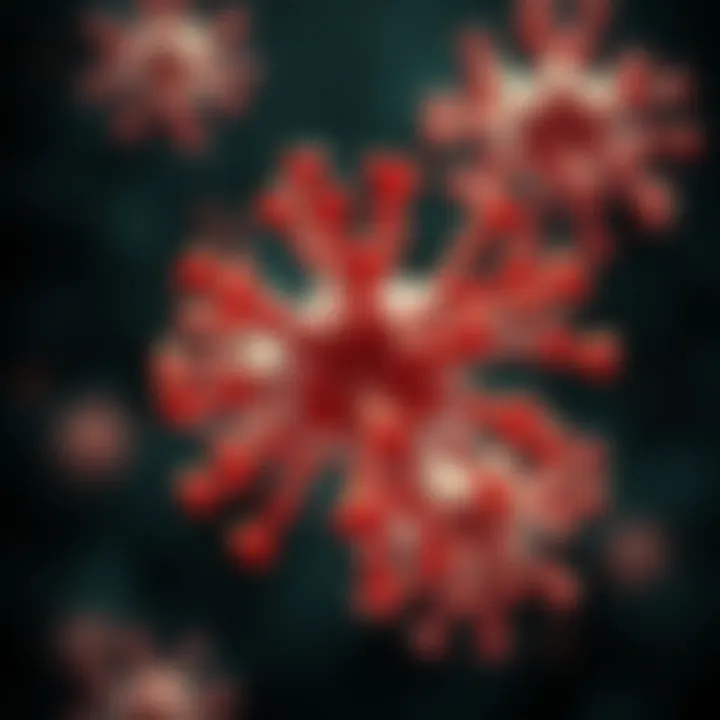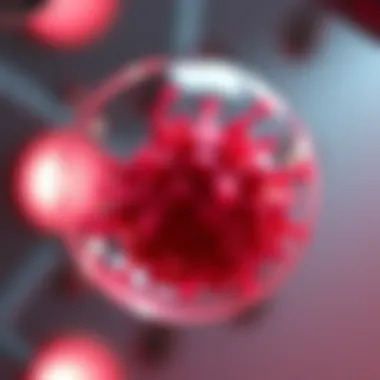Exploring Triple-Class Refractory Multiple Myeloma


Intro
Triple-class refractory multiple myeloma is a term that strikes a chord of concern among hematologists and oncologists alike. With the landscape of cancer treatment continually evolving, this particular subtype of multiple myeloma presents unique challenges, leaving patients and healthcare providers navigating a labyrinth of therapeutic obstacles. In the realm of hematologic malignancies, triple-class refractory myeloma is notable for its defiance against three different classes of treatments, namely proteasome inhibitors, immunomodulatory drugs, and monoclonal antibodies. The resistance exhibited by this form of cancer complicates treatment strategies and presents daunting hurdles for achieving sustained remissions.
Understanding this condition requires not only a grasp of the underlying biological mechanisms but also an awareness of the latest advancements in research and therapy. In many cases, this knowledgeable approach serves as a guiding light for practitioners while also informing patients about their options. From deciphering complex genomic alterations to sharing insights on clinical trials that promise new hope, there are significant areas to explore.
In the following sections, we will delve deeper into the key concepts surrounding triple-class refractory multiple myeloma, followed by a review of the current research trends, shedding light on ongoing studies and noteworthy breakthroughs. By elaborating on these topics, this guide aims to serve as a comprehensive resource for students, researchers, educators, and professionals who are keen to deepen their understanding of this challenging malignancy.
Prelims to Multiple Myeloma
Engaging with the topic of multiple myeloma is like navigating through a maze; it's complex and multifaceted, yet vital for understanding the intricacies of blood cancers. This section serves as a foundational cornerstone, setting the stage for a deeper exploration into the specific challenges posed by triple-class refractory multiple myeloma.
Understanding multiple myeloma begins with grasping its definition and classification. This is crucial as it helps in recognizing how this disease manifests and evolves, particularly in its more aggressive forms. Knowledge of the various classifications can also enlighten practitioners and students on the distinct treatment pathways and prognoses associated with different stages of the disease.
Moreover, the experience of diagnosis and treatment is shaped significantly by acknowledged classifications. By joining the dots between symptoms, classifications, and therapies, professionals can tailor their approaches more effectively. This introduction isn't just a cursory glance; it lays the groundwork for everyone involved in patient care, ensuring informed decisions that could potentially improve patient outcomes.
Feeling overwhelmed by the sheer volume of information? It's perfectly normal. The complexities of multiple myeloma warrant a deeper dive, preparing healthcare providers and researchers alike to face the challenges head-on.
Definition and Classification
Multiple myeloma is a type of blood cancer that arises from plasma cells in the bone marrow. These cells are responsible for producing antibodies that help in fighting infections. When these plasma cells become malignant, they not only proliferate uncontrollably but also crowd out healthy blood cells, leading to a plethora of complications. The classification of multiple myeloma can be traced back to several key factors, including biochemical markers, genetic mutations, and clinical symptoms.
A few primary classifications include:
- Smoldering Multiple Myeloma: A precursor stage where there are abnormal plasma cells but no symptoms are present.
- Active Multiple Myeloma: When the disease begins to exhibit symptoms, including anemia and kidney dysfunction, it is categorized as active.
- Triple-Class Refractory Multiple Myeloma: This is a particularly difficult classification characterized by resistance to multiple lines of therapy—specifically to immunomodulatory drugs, proteasome inhibitors, and monoclonal antibodies.
The understanding of these classifications is not trivial; it establishes a framework upon which treatment decisions are made and prognostic outcomes are assessed. It sets the tone for a conversation about why some patients might respond unfavorably, while others see different trajectories in their health.
Overview of Triple-Class Refractory Status
The term “triple-class refractory” can sound alarming, and rightly so. This reflects a state where the disease is resilient against three major classes of therapy. In a clinical context, this means that standard treatment options have been tried and failed, leaving both patients and physicians to face scant alternatives. Now, this scenario can lead to a chronic struggle, where repeated cycles of interventions do not yield improvement.
Resistance to treatment can stem from various mechanisms such as genetic alterations in cancer cells or adaptations in the tumor microenvironment. Clinicians often find themselves caught between a rock and a hard place, grappling with the challenge of developing innovative treatment plans while also managing patient expectations.
Take, for instance, the patient's psychological landscape; the emotional burden of being triple-class refractory can be just as overwhelming as the physical symptoms. Studies have shown a correlation between refractory status and declining quality of life, emphasizing the need for holistic care approaches. It’s not just about combating the disease; understanding these dynamics is vital for crafting comprehensive care strategies that address the complete wellbeing of the patient.
This section illuminates the weight of the challenge faced by patients with triple-class refractory multiple myeloma, emphasizing the need for ongoing research and alternative therapeutic strategies.
This section illuminates the weight of the challenge faced by patients with triple-class refractory multiple myeloma, emphasizing the need for ongoing research and alternative therapeutic strategies.
In summary, this introduction is your stepping stone into a landscape fraught with challenges, requiring knowledgeable navigation through multiple dimensions of care and research. The journey into the heart of multiple myeloma is just beginning.
Pathophysiology of Multiple Myeloma
Understanding the pathophysiology of multiple myeloma is crucial for grappling with its intricate nature. This section unravels the biological mechanisms that drive the development and progression of this hematologic malignancy. By exploring the underpinnings of multiple myeloma, we can appreciate how these factors interplay with treatment resistance, especially in cases deemed triple-class refractory. Such insights aid not only in refining diagnostic criteria but also in shaping therapeutic strategies, ultimately enhancing patient care.
Mechanisms of Disease Progression
The progression of multiple myeloma is insidious, often slipping through the cracks until it has advanced significantly. Key mechanisms of this disease can be broken down into several components:
- Genetic and Epigenetic Changes: Many patients exhibit unique chromosomal translocations that significantly alter their prognosis. For instance, the translocation involving chromosomes 14 and 16 leads to the overexpression of oncogenes. Other mutations, such as those affecting the TP53 gene, compound the complexity of the disease.
- Proliferation of Malignant Plasma Cells: In multiple myeloma, there is a notable clonal expansion of plasma cells, pushing out normal blood cells and disrupting hematopoiesis. This unchecked growth is often fueled by various cytokines released from nearby stromal cells.
- Bone Marrow Microenvironment Interactions: The relationship between myeloma cells and their surrounding microenvironment is critical. Factors secreted by the bone marrow stroma can enhance myeloma cell survival, promoting their growth while leading to niche remodeling, which ultimately hampers normal cellular function.
The intricate dance between these mechanisms manifests in various symptoms and complications in patients, revealing why addressing these factors is paramount in therapies aimed at overcoming resistance.
Role of Bone Marrow Microenvironment
The bone marrow microenvironment plays a dual role in multiple myeloma—both nurturing the malignant plasma cells and serving as a battleground where these cells undermine normal hematologic function. Here's how:
- Stromal Cell Interaction: The stroma provides a protective shelter for myeloma cells through cell-to-cell contacts and soluble factors like interleukins. These interactions can lead to increased growth signals and inhibit apoptotic pathways, allowing myeloma cells to thrive.
- Angiogenesis: In multiple myeloma, there is often an abundance of new blood vessel formation within the bone marrow. The processes stimulating angiogenesis are linked to increased levels of nutrients and oxygen, further supporting the malignant cells. This vascularization is not merely incidental; it is a critical facilitator of disease progression.
- Immune Evasion: The bone marrow niche can also enable myeloma cells to evade detection by the immune system. By modulating the immune response, myeloma cells can create an environment where immune cells are less able to target and kill them effectively.
"The microenvironment in multiple myeloma is a double-edged sword, acting as both a haven and a battleground for malignant cells."
"The microenvironment in multiple myeloma is a double-edged sword, acting as both a haven and a battleground for malignant cells."


It becomes clear that targeting not just the cancer cells but also the supportive microenvironment could enhance treatment efficacy, particularly for those with triple-class refractory disease. Such strategies involve novel approaches that aim to disrupt these interactions, potentially paving the way for more effective therapies in the future.
Clinical Presentation
When it comes to multiple myeloma, understanding the clinical presentation is pivotal. This phase not only signals how the disease manifests but also plays a crucial role in guiding treatment strategies. For clinicians and researchers alike, keeping a keen eye on the symptoms and staging can mean the difference between life and death, or at least a significant alteration in the quality of life for patients.
Symptoms and Diagnostics
Patients with triple-class refractory multiple myeloma often present a unique set of symptoms that can help in early diagnosis, although such diagnosis can still be a challenging task. Common symptoms include fatigue, bone pain, and anemia. Often, patients experience heightened levels of calcium in the blood, which leads to symptoms like excessive thirst and confusion.
- Fatigue: A prevalent complaint, nearly every patient faces debilitating tiredness due to factors like anemia and the body's struggle against cancer cells.
- Bone Pain: Resulting from lesions or fractures, this is frequently mischaracterized as simple arthritis or aging. Clinicians need to evaluate changes closely, especially in older adults.
- Renal Impairment: High protein levels from myeloma can disturb kidney function.
- Hypercalcemia: Elevated calcium levels can cause nausea, constipation, and neurological issues.
Diagnostic measures primarily hinge upon blood tests, imaging studies, and bone marrow biopsies. The International Myeloma Working Group established strict criteria for diagnosis, which often includes a combination of findings:
- Serum protein electrophoresis (SPEP) to identify monoclonal proteins.
- Urine tests for Bence Jones proteins, which further clarify the disease's presence and severity.
- Bone marrow biopsy, crucial for identifying the percentage of abnormal plasma cells and assessing genetic characteristics that might guide treatment options.
Early diagnosis can lead to better management options, making it critical for healthcare providers to act swiftly upon recognizing these symptoms.
"Recognizing the key indicators of multiple myeloma is like having a compass in uncharted waters; it guides us towards effective treatment pathways."
"Recognizing the key indicators of multiple myeloma is like having a compass in uncharted waters; it guides us towards effective treatment pathways."
Staging and Prognostic Factors
Once a diagnosis is confirmed, staging becomes integral to tailoring treatment plans. The staging determines the extent of the disease which profoundly affects prognosis and management. The most widely used is the Revised International Staging System (RISS), which categorizes patients into three stages based on levels of albumin and beta-2 microglobulin in the serum. This straightforward approach helps in predicting outcomes.
- Stage I: Characterized by low levels of beta-2 microglobulin and high albumin levels, indicating the disease is limited and has better prognosis.
- Stage II: A mid-point with varied albumin and beta-2 microglobulin characteristics, often requiring careful monitoring.
- Stage III: Renowned for high beta-2 microglobulin and typically correlating with a poorer prognosis, indicating aggressive disease.
In addition to the RISS, other prognostic factors are also under consideration, such as:
- Cytogenetic abnormalities: Certain chromosomal alterations may indicate worse outcomes, pushing the need for more aggressive treatments.
- Age and overall health: Younger patients may tolerate aggressive treatments better than older patients with multiple comorbidities.
- Response to treatment: Assessing how well a patient responds to therapies can adjust future treatment strategies.
In summary, clinical presentation, which includes understanding symptoms and properly staging the disease, acts as a significant tool for healthcare professionals. It aids in shaping the therapeutic landscape for patients grappling with this complex condition.
Treatment Resistance in Triple-Class Refractory Multiple Myeloma
Understanding treatment resistance in triple-class refractory multiple myeloma is vital for both clinicians and researchers working in the field. This particular status represents a significant hurdle, as it indicates that patients have become resistant to three main therapeutic classes: proteasome inhibitors, immunomodulatory drugs, and monoclonal antibodies. Such resistance complicates treatment strategies and negatively impacts patient outcomes, making it essential to delve into resistance mechanisms and their implications on treatment decisions.
Significance of Treatment Resistance:
The ability of multiple myeloma cells to outsmart therapies points to a profound adaptability of the disease. In this scenario, patients often endure multiple lines of therapy, each falling short. With every failed treatment, the avenues available for future interventions narrow. Understanding why these cells proliferate, despite aggressive treatment regimens, is crucial for developing new strategies that could at least slow down their progression.
Understanding Resistance Mechanisms
Resistance mechanisms in triple-class refractory multiple myeloma can be categorized into several biological factors. Some common ones include:
- Genetic Mutations: Changes in genetic material can allow cancer cells to survive and thrive even in the presence of drugs that should target them.
- Bone Marrow Microenvironment: The microenvironment not only provides physical support to myeloma cells but also aids in their survival by secreting growth factors and cytokines, essentially creating a shield against therapies.
- Drug Efflux: Myeloma cells may develop the ability to pump out therapeutic agents before they can exert their effects, rendering treatments ineffective.
While we understand some of these mechanisms, the picture is far from complete. For instance, studies have shown that myeloma cells exhibit varying responses to drugs even within the same patient, indicating a heterogeneity not just at a cellular but molecular level.
"Treatment resistance isn't merely a setback; it can often reveal the intricate dance of biology as myeloma cells adapt and evolve in response to our best efforts to combat them."
"Treatment resistance isn't merely a setback; it can often reveal the intricate dance of biology as myeloma cells adapt and evolve in response to our best efforts to combat them."
Impact on Treatment Decisions
The implications of treatment resistance ripple through clinical practice and decision-making processes. When faced with a triple-class refractory patient, several elements should be carefully considered:
- Individualized Treatment Plans: Unlike initial treatment strategies, where standard protocols may suffice, resistant cases require a tailored approach. Factors such as genetic profiling of the myeloma cells could inform better-targeted therapy options.
- Exploration of Novel Agents: New studies frequently emerge that may provide insight into promising investigational therapies. Staying abreast of clinical trial data can facilitate early access to cutting-edge interventions.
- Change in Treatment Paradigms: The traditional stepwise approach to treatment may not be effective in light of resistance mechanisms. Incorporating combination therapies may provide synergistic effects that could yield better results.
Current Treatment Approaches
The landscape of treating triple-class refractory multiple myeloma (RRMM) has become increasingly intricate. This complexity arises from the unique nature of the disease, particularly its resistance to standard therapies. By exploring current treatment approaches, healthcare professionals can grasp the effectiveness and limitations of available regimens. When it comes to navigating patient care, understanding these methods can be pivotal. The benefits of tailored treatment align with the goals of patient outcomes and overall quality of life.
Chemotherapy Regimens


Chemotherapy remains a cornerstone in managing multiple myeloma, even in its refractory stage. Traditional chemotherapeutic agents, such as melphalan and cyclophosphamide, have been employed for years, with mixed outcomes among patients resistant to multiple therapies. The challenge lies in a patient's unique genetic profile and the disease's molecular characteristics.
Recent advancements have brought forth newer combinations and dosing strategies that can potentially invigorate resistance responses. The following point highlights the types of chemotherapeutic approaches:
- Combination therapies are often more effective than single agents. For example, combining bortezomib with dexamethasone can create a more robust treatment response.
- Dosing adjustments rooted in pharmacogenomic principles can also yield better results in treatment regimens. Physicians may recommend lower doses to mitigate side effects while still achieving therapeutic efficacy.
However, what's critical in chemotherapy approaches is the ongoing assessment of the patient's response and the timely adjustment of treatment protocols.
Targeted Therapies
In the realm of targeted therapies, drugs such as carfilzomib and ixazomib aim to improve response rates in patients with triple-class refractory myeloma. These agents function by selectively disrupting specific pathways involved in myeloma cell survival and proliferation, leading to reduced tumor burden with fewer side effects compared to traditional chemotherapy.
Understanding the key aspects of targeted therapies is crucial:
- Mechanism of action: Targeted therapies hone in on specific molecular structures or genetic mutations within the myeloma cells. For example, carfilzomib irreversibly inhibits proteasomes, disrupting protein degradation pathways essential for malignant cell survival.
- Personalized approach: The utilization of biomarkers can guide therapy choices, ensuring a more individualized treatment protocol. A patient's genetic profile can significantly influence responses to these targeted agents, leading to a higher likelihood of treatment success.
Given their ability to minimize collateral damage while maximizing target cell eradication, targeted therapies have emerged as a significant advance in RRMM treatment.
Immunotherapy Advances
Emerging as a powerful weapon against multiple myeloma, immunotherapies harness the body’s immune system to combat cancer. The advent of monoclonal antibodies, such as daratumumab, has reshaped the treatment paradigm. These agents are designed to bind to specific surface proteins on myeloma cells, marking them for destruction by immune effector cells.
Key considerations in immunotherapy include:
- Mechanisms: Immunotherapy works by activating the immune response, including antibody-dependent cellular cytotoxicity (ADCC). This leads to the destruction of myeloma cells more effectively than traditional therapies.
- Combination strategies: When used in conjunction with other treatment modalities, such as chemotherapy or targeted therapies, immunotherapies can significantly enhance overall treatment outcomes.
In summary, advancing our understanding of chemotherapy, targeted therapies, and immunotherapy presents the promise of more effective strategies in treating triple-class refractory multiple myeloma. As research progresses, continuous refinements in these treatment approaches are likely to enhance patient care and provide a clearer pathway through the complexity of this challenging disease.
The challenge remains not only in developing effective treatments but also in personalizing therapy according to each patient’s unique disease profile, thereby optimizing outcomes for those battling triple-class refractory multiple myeloma.
The challenge remains not only in developing effective treatments but also in personalizing therapy according to each patient’s unique disease profile, thereby optimizing outcomes for those battling triple-class refractory multiple myeloma.
For additional readings on innovative treatment approaches, consider resources like Wikipedia or ClinicalTrials.gov.
Emerging Therapies and Research
The landscape of treating triple-class refractory multiple myeloma is continuously evolving, shedding light on a multitude of new approaches designed to combat this complex condition. The significance of exploring emerging therapies and ongoing research cannot be overstated, as they offer hope where traditional treatments may falter. A collective understanding of these avenues can equip clinicians and researchers alike with the necessary tools to enhance patient care and uncover effective treatment strategies. Essentially, the continued development in this field promises not only to improve survival rates but also to maintain a better quality of life for patients grappling with this arduous diagnosis.
Novel Drug Candidates
In recent years, the discovery of novel drug candidates has paved new pathways in the treatment of triple-class refractory multiple myeloma. Medications such as selinexor and melflufen exemplify this shift.
- Selinexor: This agent works by inhibiting the export of tumor suppressor proteins from the nucleus of myeloma cells, effectively inducing apoptosis. Its unique mechanism positions it as a feasible option for patients who have shown resistance to other treatments.
- Melflufen: An alkylating peptide conjugate, melflufen is designed to release a cytotoxic compound within the myeloma cell environment, limiting systemic toxicity. This targeted approach can potentially transform treatment for those who have exhausted conventional options.
Apart from these, researchers are investigating other promising candidates like antisense oligonucleotides and monoclonal antibodies that may offer alternative avenues to outsmart the disease. These agents reveal the ever-evolving sophistication in tackling multiple myeloma, presenting an opportunity for tailored therapies that align with individual patient profiles.
"The development of novel drug candidates marks a significant leap forward in the quest to conquer triple-class refractory multiple myeloma, highlighting an exciting era of personalized medicine."
"The development of novel drug candidates marks a significant leap forward in the quest to conquer triple-class refractory multiple myeloma, highlighting an exciting era of personalized medicine."
Clinical Trials and Their Implications
Clinical trials are the cornerstone of cancer research, acting as both a testing ground for new therapies and a beacon of hope for patients. Each trial brings with it a set of implications that extend beyond mere statistics. The insights gained from clinical trials play an instrumental role in informing treatment guidelines, shaping standard practices, and ultimately influencing patient outcomes.
- Phases of Trials: Understanding the diverse phases is essential. Phase I trials assess safety; Phase II trials provide efficacy insights; while Phase III trials compare new treatments with standard therapies, paving the way for potential approval.
- Access to Innovative Treatments: Through participation in clinical trials, patients gain access to groundbreaking therapies that are not yet available to the general public. In many cases, this can be a life-saving decision, particularly for those in dire situations.
- Impact on Treatment Protocols: Findings from these trials can lead to revisions in current treatment protocols. For instance, the success of a novel chemotherapy regimen in a trial can prompt oncologists to consider it as first-line therapy, thereby influencing future treatment decisions.
- Real-World Evidence: Beyond the controlled environment of trials, the data collected can inform real-world application, guiding physicians in tailoring therapies to fit diverse patient needs.
Ultimately, the importance of emerging therapies and the role of clinical trials extend far beyond their initial promise. They represent a unity of innovation, research, and patient empowerment, which together hold the key to advancing the management of triple-class refractory multiple myeloma.
Navigating Patient Care
Understanding the intricacies of triple-class refractory multiple myeloma demands a thoughtful approach to patient care. This particular form of multiple myeloma is not just a simple hurdle; it represents a profound challenge that requires a meticulous strategy. Navigating patient care means not only addressing the medical needs but also considering the emotional and psychological well-being of the patient.
This multidimensional approach can significantly enhance the quality of care delivered. It involves collaboration among various healthcare professionals, including hematologists, oncologists, nurses, social workers, and palliative care specialists. Such teamwork is essential. The dynamic nature of multiple myeloma means that treatment plans often need adjustments based on the patient's evolving condition and response to therapy.


Furthermore, effective communication is key. Keeping patients informed about their treatment options fosters trust and encourages compliance. Monte Carlo simulations are not required to understand that educated patients tend to engage more with their care plans and make informed decisions about their treatment pathways.
On top of that, integrating patient preferences into management strategies can lead to better satisfaction and outcomes. Acknowledging what patients value—like minimizing side effects or maintaining a certain level of daily functioning—can tailor the treatment strategies to align with their personal goals.
Multidisciplinary Treatment Approaches
When it comes to managing triple-class refractory multiple myeloma, a single-minded focus won’t cut it. Utilizing a multidisciplinary treatment approach can serve as a beacon of hope in a tumultuous landscape. Involving multiple specialists can enhance the management plan by integrating various perspectives and expertise.
- Hematologists provide insight into the biological aspects and current treatments.
- Nurses offer ongoing monitoring and patient education.
- Pharmacists ensure safe medication management and possible interactions.
- Social workers assess the support systems and resources available for patients.
- Nutritionists help patients maintain their strength and manage treatment side effects through diet.
Each professional contributes to an overall treatment plan that may be adaptable over time, thus ensuring that it fits the unique needs of each patient.
A strong support network can include participation in clinical trials, which may put cutting-edge therapies within reach of individuals who have exhausted standard treatment options.
Palliative Care Considerations
As patients navigate the murky waters of triple-class refractory multiple myeloma, palliative care becomes a cornerstone of their treatment journey. Far from merely a final destination, palliative care aims to improve quality of life from the moment of diagnosis. Here, it emphasizes supportive measures—addressing symptoms and side effects while ensuring comfort during all stages of the disease.
Effective palliative care incorporates:
- Pain management: Understanding the nuances of managing skeletal and systemic pain, utilizing both pharmacological and non-pharmacological methods.
- Emotional and psychological support: It’s not easy facing a life-altering diagnosis. Counseling and therapy should enable patients and families to cope with stress.
- End-of-life planning: Discussing future preferences regarding care can alleviate anxiety and ensure that patient goals are honored as their journey unfolds.
Importantly, palliative care is not a one-size-fits-all service; it requires continuous adjustment based on patient feedback and changing circumstances.
The goal isn't to cure the disease but to make the living as pleasant as possible amid challenges.
The goal isn't to cure the disease but to make the living as pleasant as possible amid challenges.
In summary, the multifaceted nature of triple-class refractory multiple myeloma necessitates a careful, patient-centered approach in care delivery. Integrating medical interventions with emotional and physical support can forge a path through the storm, ensuring better management and enhancing the overall quality of life for patients.
Quality of Life and Patient Outcomes
Quality of life is a critical aspect when discussing triple-class refractory multiple myeloma. The diagnosis often carries a heavy burden, not just physically but emotionally and socially as well. Effective treatment strategies must consider how interventions affect patients' day-to-day experience. It’s not solely about extending life; it's about ensuring that those additional days are filled with the least suffering possible.
Measuring Treatment Efficacy
When evaluating the efficacy of treatments, it’s essential to go beyond tumor burden reduction or clinical parameters alone. Quality of life metrics play a pivotal role in quantifying patient wellbeing. Some key aspects include:
- Physical Functioning: Assess how treatments impact daily activities. Do patients report fatigue, pain, or mobility issues? A treatment may demonstrate excellent efficacy on a cancer marker but, if it leaves patients bedridden, what's the trade-off?
- Emotional Wellbeing: Psychometric tools can help gauge mood changes, feelings of anxiety, or situations of depression during treatment cycles. For instance, patients undergoing certain chemotherapy regimens might report significant emotional tolls.
- Patient-Reported Outcomes (PROs): These help track how patients perceive their health status. Employing validated questionnaires aids clinicians in adjusting treatment plans based on patient feedback, ensuring that treatments align with patient goals.
While measuring these aspects can be challenging, innovations in digital health platforms are aiding data collection and can provide real-time insights into patient experiences.
Psychosocial Impacts on Patients
The emotional and psychological facets of living with triple-class refractory multiple myeloma are often overlooked. However, understanding these elements is paramount for effective treatment. Patients may experience:
- Isolation: Many face feelings of seclusion due to illness, which can heavily impact their quality of life. Peer support groups can alleviate feelings of loneliness, helping patients connect and voice their fears or hopes.
- Fear and Uncertainty: Continuously dealing with disease progression or treatment failure brings about a plethora of fears. These can manifest into various psychological symptoms, affecting their motivation towards treatment compliance.
- Family Dynamics: The toll on relationships can be quite profound. Caregiving responsibilities may shift, leading to internal family conflicts. Understanding these dynamics helps caregivers and medical professionals better support the entire family unit.
Psychosocial support should not be an afterthought. Integrating mental health resources and social support into the treatment regimen can lead to improved patient outcomes and a better quality of life.
Closures and Future Directions
The journey through triple-class refractory multiple myeloma is like navigating a labyrinth where each twist and turn reveals new challenges and insights. Understanding the current state of this complex disease and its treatments is not just important—it’s essential for progress. This article has delved into various facets of triple-class refractory multiple myeloma, shedding light on pathophysiology, resistance mechanisms, and treatment approaches. As we reach the conclusion, it’s critical to piece together the knowledge we’ve gathered and explore the future directions that lie ahead.
Summarizing the Current Landscape
The landscape of triple-class refractory multiple myeloma is ever-evolving.
- Existing treatments have laid the groundwork but have shown limited success in certain cohorts, emphasizing the necessity for tailored approaches.
- Research advancements have led to exciting developments in therapies aimed at targeting resistant cancer cells, such as CAR T-cell therapy and bispecific antibodies. These therapies aim to improve patient outcomes by navigating around the resistance barriers that define this disease's challenging nature.
- Patient care strategies are shifting towards a more integrated approach. This involves multidisciplinary teams that collaborate to address not only the medical needs but also the psychological and emotional well-being of patients.
In short, the current framework for managing triple-class refractory multiple myeloma is layered with complexities, requiring continuous adaptation to the evolving understanding of the disease.
Implications for Ongoing Research
The implications for ongoing research in triple-class refractory multiple myeloma cannot be overstated. As researchers dive deeper into the molecular underpinnings of resistance, several key elements emerge:
- Innovative drug development is essential. Novel agents that target specific pathways or use unique mechanisms of action are critical for overcoming the existing treatment hurdles.
- Genomic profiling can offer insights into how different patients respond to treatments, allowing for a more personalized medicine approach. This is significant as it opens the door for precision therapies that align with individual patient profiles.
- Longitudinal studies are important for tracking treatment responses over time and understanding the patterns of relapse. They can provide invaluable data that can shape clinical practices.
The path forward lies in turning the tide on resistance through innovative solutions and collaboration across disciplines. No single approach will suffice, as the complexity of this disease requires a comprehensive understanding and a multifaceted strategy.
The path forward lies in turning the tide on resistance through innovative solutions and collaboration across disciplines. No single approach will suffice, as the complexity of this disease requires a comprehensive understanding and a multifaceted strategy.







